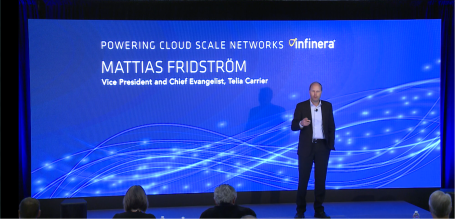Transforming the Intelligent Transport Network to Cloud Scale
December 5, 2016 at 11:53 AM Leave a comment
 By Pravin Mahajan, Director of Product Marketing
By Pravin Mahajan, Director of Product Marketing
The telecom industry continues to undergo significant transformation, with another year of rapid change in 2016. We saw multiple service provider mergers and acquisitions, while new services and technologies emerged – 5G, the Internet of Things, artificial intelligence, virtual reality and more. Amidst these changes, some fundamental trends continue—bandwidth demand keeps increasing and cost pressure remains high. Network operators are responding to these changes by streamlining their infrastructures to the simple Layer C (cloud services) and Layer T (intelligent transport) model, virtualizing as many network functions as possible in Layer C by taking advantage of nearly unlimited low-cost compute available in data centers worldwide to move to a simpler and more scalable Layer T optical network for moving bits between data source and sink.
As this generational shift in network architecture evolves, we are witnessing a striking change in Layer T traffic patterns. For example, on trans-Atlantic links, private traffic, mainly between data centers, is growing at more than double the rate of overall public internet traffic. This web scale private traffic requirement is typically at rates of N x 100 Gb/s, often characterized as “elephant flows,” and results in more linear traffic patterns. The network infrastructure serving this demand needs to be cost-optimized for this sort of traffic pattern, and takes its cues from web scale infrastructure used by internet content providers – it needs to be scalable, disaggregated and open.
Meanwhile, the public internet user-to-data center traffic requirement is more mesh-oriented, consisting of a multitude of “mice flows” that connect to and from businesses, cell towers, Wi-Fi hot spots and broadband internet connections. Network platforms handling these flows need to be able to groom/aggregate these small sub-wavelength flows to fully pack wavelengths and add and drop traffic as the aggregated flows traverse various points in the network. Thus the equipment for these flows needs to be flexible, with granular sliceability and switching integrated in a single chassis with dense wavelength-division multiplexing (DWDM) and enhanced with security. With the advent of these elephant flows now being carried more frequently across service provider networks, a true cloud scale network isn’t an either/or choice between web scale and telco-grade capabilities; rather, it is a fusion of the two, blending scalability with sliceability, disaggregation with integration, and openness with security.
At Insight Infinera 2016, held last month, Infinera and customer executives expanded on the next generation of unified intelligent transport networks and the requirements of this cloud scale. Chris Aspell, Director of Strategy at Liberty Global, one of the largest cable companies in the world, emphasized the importance of a Layer T and C architecture for building networks. He wryly observed that Liberty Global is undergoing a big initiative to transform its own network architecture, which is akin to changing the wheels on a car while driving it on the road. Chris stated that the new network model helps consolidate multiple operational teams across 11 countries into one team, and by leveraging Layer T to improve network simplicity and efficiency. Liberty has leveraged the Layer 2 packet services available on the widely deployed XTM Series packet-optical platforms deployed throughout their network enabling them to remove routers from the service edge of their network. This optimization reduces power by 75% and ultimately saves 40% on network total cost of ownership (TCO). Mattias Fridström, Chief Evangelist at Telia Carrier, showed an interesting chart about bandwidth seasonality. Every year bandwidth dips in July and picks up by September. This year, however, the July dip was deeper, without any plausible explanation. But sure as day follows night, traffic came back to its usual level in September. Mattias also described how mobile phone software releases wreak havoc on network bandwidth. To address the traffic changes, Telia has adopted scalable super-channels and Infinera Instant Bandwidth technology on its network and talked about Telia’s positive view of having the right set of tools to handle both elephant and mice flows. Mattias stressed the need to invest in networks, as there is no end in sight to bandwidth growth even as the mix is now dominated by private traffic.
As customers like Liberty Global and Telia Carrier expand and optimize their infrastructures, they are looking to Infinera’s next-generation unified Intelligent Transport Network architecture that blends the best of web scale technologies with telco-grade technologies to provide a full toolset that allows service providers to optimize their networks for transporting both elephant flows and mice flows at the lowest TCO. Infinera is delivering this next generation architecture with new solutions powered by the Infinite Capacity Engine, the industry’s only multi-terabit optical engine. Earlier in the year, Infinera announced the Cloud Xpress 2, raising the bar for data center interconnect. At Insight Infinera, we announced the world’s first meshponder – a new category of platforms motivated by web scale disaggregation principles. The DTN-X XT-3300 and XT-3600 meshponders combine super-channel scalability with sliceable photonics in an ultra-compact form factor without the complexity of integrated switching. For example, the XT-3300 is 1 rack unit (1RU), with one fiber pair, installed in one operational motion with 1.2 terabits per second (Tb/s) of line-side capacity across six channels – rack-and-stack with operational simplicity combined with mesh optical functionality. We also upgraded the existing integrated wavelength-division multiplexing (WDM) and packet-aware switching platforms, DTN-X XTC-10 and XTC-4, with 1.2 Tb/s per slot capability. And we added a new compact chassis and a 20-port super-channel reconfigurable optical add-drop multiplexer (ROADM) to FlexILS, the industry’s most widely deployed flexible grid open line system. All these solutions can be software-controlled using the Xceed Software Suite, which breaks new ground in Transport SDN (software-defined networking) with a purpose-built OpenDaylight-enabled platform and revenue-ready applications. By bringing these capabilities into the next-generation unified Intelligent Transport Network, service providers can dramatically decrease TCO through reduced equipment, power and space consumption, as proven by modeling on a specific customer network topology which resulted in a 56% TCO savings.
Infinera continues to work with our customers to transform Layer T to cloud scale by harnessing its rich experience with building products for both web-scale and telco operators and delivering a next-generation unified Intelligent Transport Network architecture. Certainly 2016 has been a busy year of product and technology introductions at Infinera, culminating with Insight Infinera at our Silicon Valley headquarters. If you missed the event, you can view it on-demand here.
Related links:
- Press Release: Infinera Powers Cloud Scale Networks with New DTN-X Platforms
- Web page: Infinera DTN-X Family
- Web page: Infinera Infinite Capacity Engine
Entry filed under: Cloud, Data Centers.









Trackback this post | Subscribe to the comments via RSS Feed